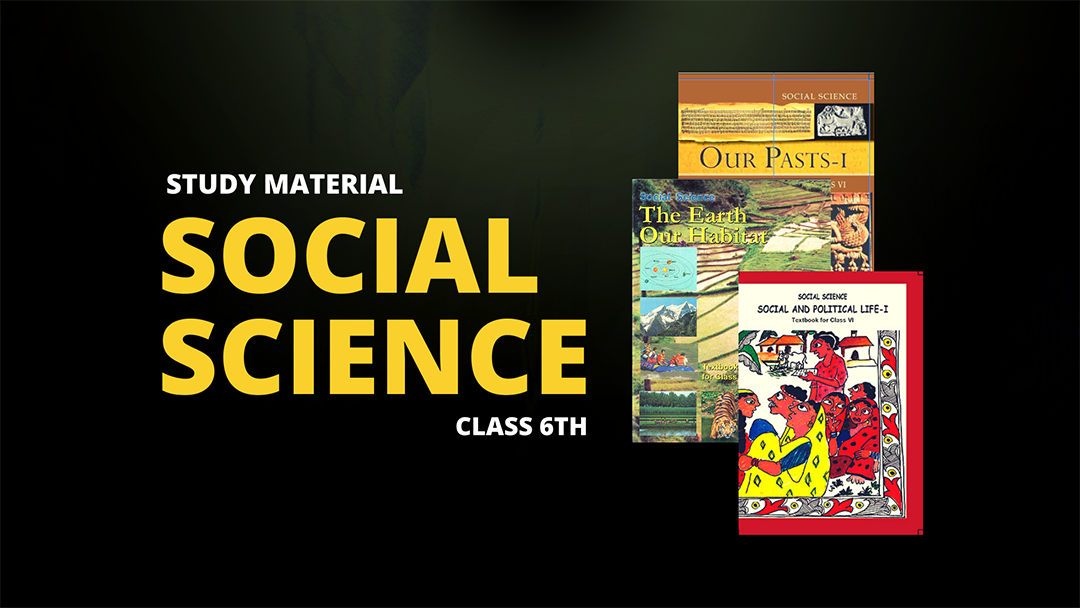
Class 6 Social Science is one of the core subjects that forms an important part of the student’s curriculum. Social Science can be one of the scoring subjects for the students of Class 6 if they know how to go about studying it. The subject consists of three parts, History, Civics, and Geography. All the three are given in separate books. The subject, on the whole, is very important to build some basic social concepts. The different books available are the Geography book, the Earth our habitat, History book, History our past, and the Civics book, Social and Political Life.
Speaking of the subject of History, there are 12 chapters in this book. The first chapter gives brief introductions about History, Archaeology, and Manuscripts. The consecutive chapters talk about the evolution and development of mankind, the important civilizations like the Harappan civilisation and how the books and burials can tell us more about each generation. The chapters then move on to tell us about various kings and their kingdoms, including Ashoka, who was a great emperor who gave up war.
There is also mention of Gautam Buddha and Mahavira and their life and realisations. Towards the end, we get to know about various village dynamics, the professions, trade, barter system leading to different trade routes. Another important topic is one that covers the rule of Gupta and Maurya. At the end of this subject, the students will have rich knowledge about the country’s history and heritage.
Looking at the second subject, Geography, which is another important subject, the students can get a better understanding of the geographic elements in the world. There are eight chapters in this subject, starting from the first chapter, which covers basics like the solar system, planets, and stars. The next few chapters talk about latitudes and longitudes, how to read a map and touches upon the different motions of the earth and the phenomena it results in.
The last part of the subject is Social and Political Life. This book has about nine chapters, and they basically talk about the Civics of our country. Important topics like diversity, government and democracy are introduced. Other interesting topics include Panchayati Raj and the type of administration in rural areas. The subject also gives a gist of administration in urban areas as well. This subject is not only interesting as it talks about real-life situations and references, but also very scoring if the student knows how to answer the questions.
Chapter 1: What, Where, How and When
Chapter 2: On The Trail Of The Earliest People
Chapter 3: From Gathering To Growing Food.
Chapter 4: In the Earliest Cities
Chapter 5: What Books and Burials Tell Us?
Chapter 6: Kingdoms Kings and the Early Republic
Chapter 7: New Question and Ideas
Chapter 8: Asoka, The Emperor Who Gave Up War
Chapter 9: Vital Villages, Thriving Towns
Chapter 10: Traders, Kings and Pilgrims
Chapter 11: New Empires and Kingdoms
Chapter 12: Buildings, Paintings and Books
Chapter 1: The Earth in the Solar System
Chapter 2: Globe: Latitudes and Longitudes
Chapter 3: Motions of the Earth
Chapter 4: Maps
Chapter 5: Major Domains of the Earth
Chapter 6: Major Landforms of the Earth
Chapter 7: Our Country – India
Chapter 8: India: Climate, Wildlife and Vegetation
Chapter 1 | Understanding Diversity |
Chapter 2 | Diversity and Discrimination |
Chapter 3 | What is Government |
Chapter 4 | Key Elements of a Democratic Government |
Chapter 5 | Panchayati Raj |
Chapter 6 | Rural Administration |
Chapter 7 | Urban Administration |
Chapter 8 | Rural Livelihoods |
Chapter 9 | Urban Livelihoods |
Gurucool – Coolfluencing the world
Gurucool is an educational networking platform that offers a suite of phygital tools to connect learners and educators. Our vision is to personalize the world’s education and make it universally accessible and empathetic.
Lets’s learn, grow thrive in our own space and time!